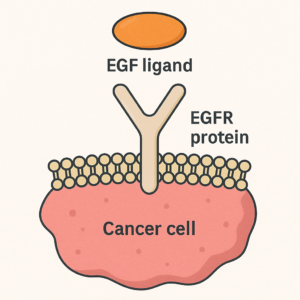Cimavax-EGF
Before we talk about what this drug is and what it does, we need to explain what EGFR is as this drug inhibits EGFR.
The EGFR receptor (short for Epidermal Growth Factor Receptor) is a protein found on the surface of many cells, and it plays a key role in cell growth, survival, and division.
In cancer, especially certain types like non-small cell lung cancer (NSCLC), particularly adenocarcinoma type, EGFR is mutated as in cancer uses the EGFR to grow, divide and survive.
There are coding segments in the EGFR called exons which affect the function of the EGFR protein.
There are different Exons in the EGFR protein.
It’s when these Exons are mutated or malfunctioning that it affects the function of the EGFR protein.
Although there are so many EGFR inhibitor drugs on the market, these EGFR inhibitor drugs are designed according to the Exon mutations within the EGFR.
The two most common mutations in the EGFR gene (which affect the EGFR protein) are:
Exon 19 deletions (~45–50% of all EGFR mutations)
Exon 21 L858R point mutation (~40–45%)
So although there are many EGFR inhibitor drugs on the market, each one of them target a certain Exon mutation.
This is good news as far as treatment and treatment outcomes goes for NSCLC Adenocarcinoma type because once these drugs work, these patients are cancer free at the moment and live healthy lives up until the cancer becomes resistant to the drugs.
However they can then try an another drug because after all there’s so many EGFR inhibitor drugs available.
Even if all the drugs they tried and became drug resistant overtime, they can try the first drug they were on and it sometimes works again.
There’s a wonderful EGFR lung cancer group for this
Now, these drugs on the market that are EGFR inhibitors are specifically targeting the exons of EGFR, or to make you easily understand this, we’ll call them subtypes of EGFR. These drugs are targeting the EGFR subtype mutations.
Mutations are in the EGFR subtypes.
EGFR Mutations are seen primarily in NSCLC.
Other Cancers generally don’t have EGFR Mutations but rather they can have EGFR Overexpression.
EGFR Mutation and EGFR Overexpression are different from each other.
EGFR Overexpression means there are lots of EGFR proteins on the surface of cancer cells and more of these proteins on the surface of cancer cells means more cancer cell division and growth.
There are drugs that target EGFR overexpression, they are monoclonal antibodies like the likes of Cetuximab, Necitumumab and Panitumumab.
Other cancers overexpress EGFR.
One of these is Penile Cancer which has a very low survival rate and the treatment for is gruesome.
EGFR Overexpression is commonly observed in penile squamous cell carcinoma (SCC), prevalence rates ranging from 91% to 100%.
95% percent of penile cancer is Squamous cell carcinoma (SCC) and is prominently expressed in the epithelium of the skin.
EGFR is a key factor in “epithelium” cancer and its activity enhances tumor growth, invasion, and metastasis.
When you block EGFR then you block the tumor growth, invasion and metastasis.
These monoclonal antibodies drugs have their share of side effects and the treatment success is low and dependent on other factors.
This is where Cimavax-EGF comes into the equation.
Cimavax-EGF is an intramuscular injection drug that inhibits EGF from binding to EGFR.
EGF is a ligand that binds to the EGFR receptor.

It was developed in Cuba and currently available only in Cuba.
There are no EGF inhibitor drugs that are FDA approved on the market.
This is the only one in Cuba.
Why isn’t this available for cancer treatment is the question we should be asking.
Why do cancer patients need to travel to Cuba to get this treatment and there have been many cancer patients that have done so but they had to pay paid out of pocket which also includes flight fares and those add up.
